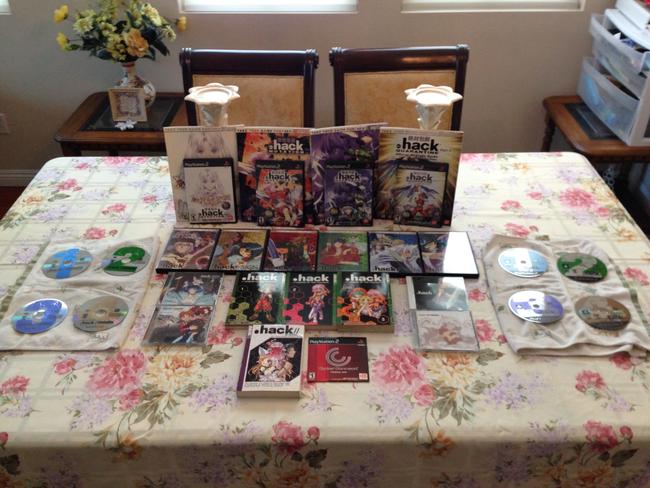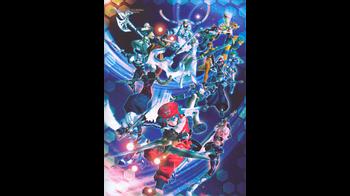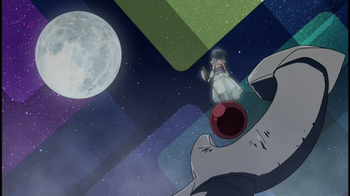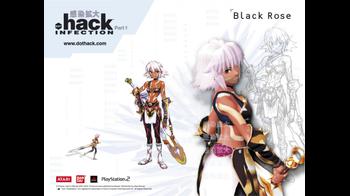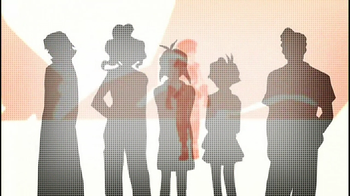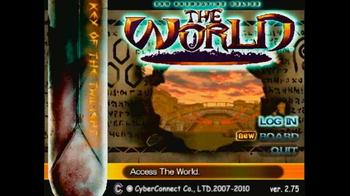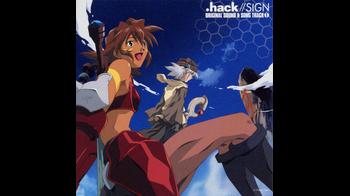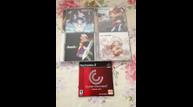Branching Path: Cross Media Galore - The Project .hack Sanctum

Entire worlds are crafted on a regular basis when developing video games. The characters, the mechanics, the regions, the architecture, the beliefs, and even the clothing all contribute to shaping those realms as we see it. Even though we’re not always mindful of how a game’s world design reflects the intent of its developers, the overall atmosphere seems to always leave some sort of impression on us.
The hours that we spend inhabiting that virtual space leaves a mark – no matter how big or small it may be.
Sometimes a game alone isn’t enough to satisfy understanding the bigger picture. A considerable handful aim to flesh out their settings further and they go beyond picking up the controller - novels, comics, manga, films, TV shows, and more. While merchandising is the economical side of the coin to further increase profits, a few set out to give insight of a much greater perspective.
I welcome you to this second entry to the Branching Path, an ongoing series of articles that shed some light on a writer’s passions. This time, I’ll be exploring an early experimental RPG undertaking which weaved together a universe through multiple platforms; enter Project .hack (pronounced dot hack).
Many RPG fans may have heard of .hack; it’s best known for being a single player game emulating a MMORPG experience. Players in the .hack universe wear virtual reality headsets for an in-game MMORPG known as The World. While the headset is used for looking around, The World’s players control their avatars with a controller that looks like a Dualshock and Dreamcast controller mashed together.
Project .hack encompasses everything .hack-related before the beloved .hack//G.U. series entered the limelight.
What initially lured me into giving .hack a shot were early visuals of the artwork in the first game, .hack//Infection. Sharp character designs from the legendary Yoshiyuki Sadamoto (best known for his work in Neon Genesis Evangelion) mixed bold, solid colors with fantastical costumes exhibiting their own unique touches. Digging deeper, seeing small clips of the game in motion perked up my interest with this intriguing concept of a single player game replicating an online experience.
My first taste of .hack didn’t come in the form of a video game though. I only stumbled upon pictures and advertisements of Infection by chance, but its odd name remained in my mind. Much to my surprise, I was flipping through TV channels one night and saw some anime episodes were airing.
After a few minutes, the start of a new show was making its debut. Then, it hit me.
Familiar words flashed through my TV screen, yet it was somehow different - .hack… SIGN? I recognized half of the title, but what was this strange entity by the name of SIGN? Back then, I had no idea that this was my descent into a mysterious world linked together by various forms of media reinforced by a passionate community. Little did I know that I was already caught inside the Project .hack vortex.
It’s easy to pinpoint what kept me hooked to .hack. While the distinct art design caught my eye, the characters kept me an avid fan of the franchise to this day. From the original tetralogy of video games (Infection, Mutation, Outbreak, and Quarantine) to the SIGN anime and the Liminality anime OVAs (original video animations), the scope at the time was out of this world in my eyes.
Project .hack had a unique challenge when it came to tackling characters. Due to The World, each and every character needed both an avatar and a person in the real world controlling that character. While a chunk of these people never received art for both ends, the writing needed to be consistently accurate in the logic processes of these characters. Would the chivalrous Balmung act like a thug in real life? What kind of mannerisms would Mai Minase display in The World in her first time playing?
It’s these little details to consider that strengthen the cohesiveness of Project .hack’s commitment in constructing an immersive universe. Even though not every character is treated with the same amount of care, there are enough relationships between primary and secondary characters that provide a sense of meaningful interpersonal development between these fictional individuals.
Another fascinating aspect in this massive cross-media tale is the ever-changing state of politics both in The World and the real world. It questioned what new dynamics come into play in a virtual space opposed to what we’re accustomed to seeing in our lives. People in power can’t snap their fingers and ban us from our physical bodies, but they totally can with our player characters inside this MMORPG.
Power structures are explored to varying degrees that reflect real-life scenarios. Helba is a super hacker that exists above the law; she possesses abilities that can’t be chained down. This is similar to how a long-standing elusive criminal manages to dodge authoritative figures again and again, building up a long chain of cold cases in his or her trail. Of course, the significant contrast lies in that one exercises her power out in the open while the other must remain incognito.
Plus, the state of politics doesn’t stay static. Significant events shake up the nature of The World bringing current organizational establishments into question. Political pillars from .hack//SIGN to the games and then onto the manga follow-up, .hack//Legend of the Twilight, differ from one another due to momentous shifts in power as a result of how the story unfolds. It’s these kinds of elements that absolutely enthrall me when it comes to world-building in .hack.
As for character writing, motivation is an additional tricky factor to consider. It’s only natural that people each have their own reason for playing The World – some want to escape real life for a bit while for others, it’s more of an obligation to a group. While most of these core reasons are mundane, the main characters in Project .hack often find themselves in a series of unfortunate events that tie them into The World, whether they like it or not.
Tsukasa from .hack//SIGN finds that he is unable to log out from the game and Kite in the video games searches for a way to rescue his friend, Orca, from a coma suspected to be caused by The World itself. These exclusive perspectives add that bit of personal stake in what would widely considered be an impersonal hobby overall.
Whether you’re taking control of Kite or spectating Tsukasa from the other side of the screen, it’s easy to become empathetic to their personal plights. They continuously struggle against an unimaginable situation and attempt to take steps to rectify them gradually. It was always a delight seeing how new characters would react after hearing their situations ranging from shock, disbelief, doubt, and suspicion though a few were willing to believe it immediately.
Perhaps the most effective tactic in the .hack narrative emerges from how it eloquently handles cause and effect. The ongoing arc that surrounds Elk and Mia is built meticulously to a certain degree; Elk’s attachment to Mia manifests itself throughout the games as the aura of enigma surrounding Mia subtly leaves players questioning her every move. While their relational development doesn’t seem impactful at first, its climax is one of the most emotional scenes in the entire series.
Cause and effect also springs up in the form of one’s origins and legacy. The prequel novel, .hack//AI Buster, details how Orca and Balmung came to be known as the Descendents of Fianna and were crowned their official titles – Orca of the Azure Sea and Balmung of the Azure Sky. This provided further insight as to why Balmung is so hesitant to assist in Kite’s efforts to wake Orca from his coma.
Above all, presentation plays an absolutely critical role at the heart of Project .hack. Carrying an air of mystery and wonder behind each new product, it left fans constantly guessing at what would happen next. Methodical build-ups escalated to dramatic, fateful encounters wagering lives on the line. Things never seemed to unfold at face value and catastrophe brought about severe ripples.
The final encounter with Cubia, the key decision surrounding Kite’s Twilight Bracelet, and the ramifications from that battle shook my soul. I rarely feel this amount of emotional investment out of games, but the cross-media strategy enveloped me into the .hack world.
I recall my joyful demeanor whenever I strolled into a Best Buy scouring the DVD section for the next .hack//SIGN volume. Its gripping plot left me hungry for more.
Beyond just how it presented its sequence of events, aesthetic decisions contributed to my desire to build a collection that now house my fond memories of the series. Every installment of the PlayStation 2 games came with an additional disc that carried an episode of .hack//Liminality - an “appetizer” before starting the game that has an ongoing set of separate events and characters that emphasize more of the real world aspect of the series. Both game and Liminality discs had a sleek number of its volume containing line-art of a key character in that entry; the thematic colors on them coincided with one another, but their color placement was reversed from the other.
.hack//SIGN, on the other hand, consisted of six DVD volumes that were cleverly titled – Login, Outcast, Gesalt, Omnipotence, Uncovered, and Terminus. All thematically fitting terms, they spell out “LOGOUT” from their spines when all six are displayed on a shelf. It’s a minor touch, but very much an endearing one nonetheless.
It was sleek. It was clever. It was pleasing to the eyes.
Both felt like a complete package that you were ready to dive into once more.
This also extends to the various user interfaces and heads-up displays throughout the games. In the world of .hack, The World runs on PCs with an operating system from the somewhat shady ALTIMIT Corporation. Each of the four games has their menu displayed through this faux PC. Even though The World is the only playable item on that list, there are still a handful of things to explore before indulging yourself in the game-within-the-game.
Various characters will contact you from time to time via email to discuss plans and tell you a little more about themselves at certain points throughout the storyline; some allow you to respond to gain further information about them. A message board for The World is also in place to gain a sense about the state of the fictional community and what kinds of topics are being discussed. Not everything is vital to your mission, but that’s part of the point.
Not everything was always on point for .hack to me. As much as I adore the franchise, the Project .hack era’s games didn’t have the most thrilling gameplay. Most of its mechanics become rather stale partway through Infection with very little introduced in future installments to vary it up.
Players execute basic attack patterns with an equipped weapon. Bringing up a menu will freeze combat to allow time to select a skill, spell, or item. A handful of quirks revolving around the Data Drain system can introduce Virus Infections to your party of three. It eventually became monotonous to play on repetitive fields and dungeons, but the tetralogy did showcase some exciting boss encounters with a few tricks up their sleeves.
SIGN's problems manifest from its slow flow to it. A great percentage of the show involved character building and it usually involved a lot of scenes with several cast members caught up in extended conversations. There are only a handful of action scenes unlike the games, so this shift in pace between mediums caught many off-guard.
So why struggle till the end? Why not quit if the gameplay became wearisome as the hours piled on? Why spend hours watching a show with seemingly nothing going on most of the time? Well, the charming characters and engaging plotline were definitely main reasons to keep on going. The major reason that I saw it through was an unlikely element that’s now crucial to me in all forms of media – music.
I never thought of music and general sound design all that much until Project .hack. Its emotional tunes filled with percussions and an emphasis on the violin and piano continue to leave an impression on me. Powerful tracks transported me to the vast environments inside The World.
The original soundtrack of .hack//SIGN did the best job highlighting the spirit of the entire project. Yuki Kajiura’s collaboration with Emily Bindiger was a match made in heaven to my ears; Kajiura’s atmospheric style meshed well with Bindiger’s soft, ethereal vocals to create a harmony unlike any other. It also helped that these songs were all sung in English so it was easy to understand the meaning and intent behind her wonderfully woven lyrics.
Standout tracks from SIGN like "Open Your Heart" and "Key of the Twilight" echo the show’s themes of solitude, confusion, and mystique. Even non-vocal tracks such as the outstanding theme of BT emphasize a prevailing sense of complication through melancholic sorrow. Meanwhile, Subaru’s themes of "Fake Wings" and "Broken Wings" showcase a progression of facetiousness to powerlessness.
When it comes to the games’ musical direction, Chikayo Fukuda and Seizo Nakata do a spectacular job instilling a dramatic tone into key cutscenes. The notable theme from the Hidden Forbidden Holy Ground presents a religious factor that ties closely with .hack’s central enigmatic figure, Aura.
I thought it was great that both SIGN and the games weren’t afraid of being spiritual with their sounds, since both plotlines involve a certain amount of faith from the protagonists amidst impossible odds.
Though the OST for the games were generally on the more techno side, I enjoyed the rural sound from the town themes, though my favorite tracks were all related to Cubia - drastic, dreary, desperate, and sometimes even downright depressing.
.hack is not a perfect series, but it’s one of the keystones in video games that gave me a new perspective in how I see them. Though gameplay isn’t one of its greatest strengths, the quality of its execution from characters to story to music still has a special place in my heart.
While .hack today is far from its former glory, I'll never forget how it shaped my perspective in life. The remaining traces of .hack lie within a Japan-exclusive mobile game called New World Vol. 1: Maiden of Silver Tears. I tried it briefly in its first few weeks, but I wasn't too fond of it. Still, I remain hopeful that .hack will return one day to a proper console or handheld and maybe reignite my fervor for it once more.
Tackling a cross-media strategy is immensely challenging, but it paid off on my end. My endearment for .hack wouldn’t amount to much if I only played the video games. The combination of watching .hack//SIGN and .hack//Liminality, listening to its beautifully crafted OSTs, and continuing the journey through manga and novels let me live in that world for a brief period, and it was certainly a sweet one.
Thank you for joining me in this second installment of the Branching Path. I hope you enjoyed it.
